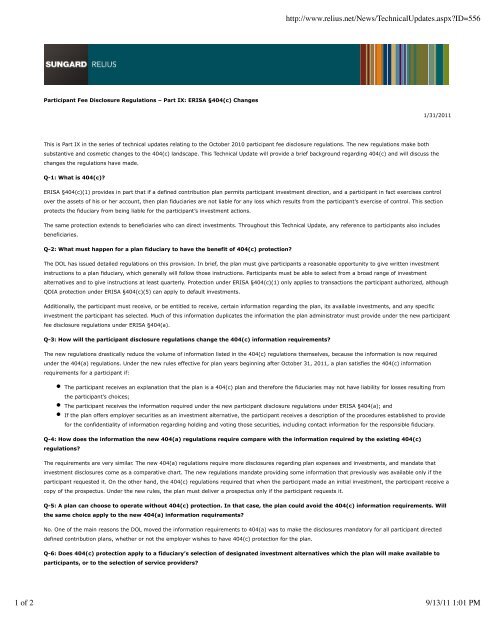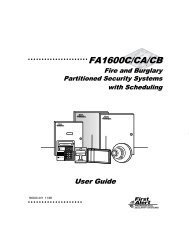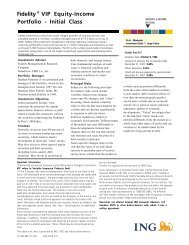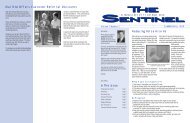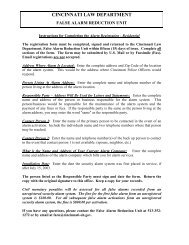http://www.relius.net/News/TechnicalUpdates.aspx?ID=556 1 of 2 9 ...
http://www.relius.net/News/TechnicalUpdates.aspx?ID=556 1 of 2 9 ...
http://www.relius.net/News/TechnicalUpdates.aspx?ID=556 1 of 2 9 ...
Create successful ePaper yourself
Turn your PDF publications into a flip-book with our unique Google optimized e-Paper software.
<strong>http</strong>://<strong>www</strong>.<strong>relius</strong>.<strong>net</strong>/<strong>News</strong>/<strong>TechnicalUpdates</strong>.<strong>aspx</strong>?<strong>ID=556</strong><br />
Participant Fee Disclosure Regulations – Part IX: ERISA §404(c) Changes<br />
1/31/2011<br />
This is Part IX in the series <strong>of</strong> technical updates relating to the October 2010 participant fee disclosure regulations. The new regulations make both<br />
substantive and cosmetic changes to the 404(c) landscape. This Technical Update will provide a brief background regarding 404(c) and will discuss the<br />
changes the regulations have made.<br />
Q-1: What is 404(c)?<br />
ERISA §404(c)(1) provides in part that if a defined contribution plan permits participant investment direction, and a participant in fact exercises control<br />
over the assets <strong>of</strong> his or her account, then plan fiduciaries are not liable for any loss which results from the participant’s exercise <strong>of</strong> control. This section<br />
protects the fiduciary from being liable for the participant’s investment actions.<br />
The same protection extends to beneficiaries who can direct investments. Throughout this Technical Update, any reference to participants also includes<br />
beneficiaries.<br />
Q-2: What must happen for a plan fiduciary to have the benefit <strong>of</strong> 404(c) protection?<br />
The DOL has issued detailed regulations on this provision. In brief, the plan must give participants a reasonable opportunity to give written investment<br />
instructions to a plan fiduciary, which generally will follow those instructions. Participants must be able to select from a broad range <strong>of</strong> investment<br />
alternatives and to give instructions at least quarterly. Protection under ERISA §404(c)(1) only applies to transactions the participant authorized, although<br />
QDIA protection under ERISA §404(c)(5) can apply to default investments.<br />
Additionally, the participant must receive, or be entitled to receive, certain information regarding the plan, its available investments, and any specific<br />
investment the participant has selected. Much <strong>of</strong> this information duplicates the information the plan administrator must provide under the new participant<br />
fee disclosure regulations under ERISA §404(a).<br />
Q-3: How will the participant disclosure regulations change the 404(c) information requirements?<br />
The new regulations drastically reduce the volume <strong>of</strong> information listed in the 404(c) regulations themselves, because the information is now required<br />
under the 404(a) regulations. Under the new rules effective for plan years beginning after October 31, 2011, a plan satisfies the 404(c) information<br />
requirements for a participant if:<br />
The participant receives an explanation that the plan is a 404(c) plan and therefore the fiduciaries may not have liability for losses resulting from<br />
the participant’s choices;<br />
The participant receives the information required under the new participant disclosure regulations under ERISA §404(a); and<br />
If the plan <strong>of</strong>fers employer securities as an investment alternative, the participant receives a description <strong>of</strong> the procedures established to provide<br />
for the confidentiality <strong>of</strong> information regarding holding and voting those securities, including contact information for the responsible fiduciary.<br />
Q-4: How does the information the new 404(a) regulations require compare with the information required by the existing 404(c)<br />
regulations?<br />
The requirements are very similar. The new 404(a) regulations require more disclosures regarding plan expenses and investments, and mandate that<br />
investment disclosures come as a comparative chart. The new regulations mandate providing some information that previously was available only if the<br />
participant requested it. On the other hand, the 404(c) regulations required that when the participant made an initial investment, the participant receive a<br />
copy <strong>of</strong> the prospectus. Under the new rules, the plan must deliver a prospectus only if the participant requests it.<br />
Q-5: A plan can choose to operate without 404(c) protection. In that case, the plan could avoid the 404(c) information requirements. Will<br />
the same choice apply to the new 404(a) information requirements?<br />
No. One <strong>of</strong> the main reasons the DOL moved the information requirements to 404(a) was to make the disclosures mandatory for all participant directed<br />
defined contribution plans, whether or not the employer wishes to have 404(c) protection for the plan.<br />
Q-6: Does 404(c) protection apply to a fiduciary’s selection <strong>of</strong> designated investment alternatives which the plan will make available to<br />
participants, or to the selection <strong>of</strong> service providers?<br />
1 <strong>of</strong> 2 9/13/11 1:01 PM
<strong>http</strong>://<strong>www</strong>.<strong>relius</strong>.<strong>net</strong>/<strong>News</strong>/<strong>TechnicalUpdates</strong>.<strong>aspx</strong>?<strong>ID=556</strong><br />
According to the final regulations, no. The regulations state that 404(c) protection does not relieve a fiduciary “from its duty to prudently select and<br />
monitor any service provider or designated investment alternative <strong>of</strong>fered under the plan." While the DOL has long contended that this is the case, courts<br />
have sometimes interpreted 404(c) more broadly. The final regulations attempt to narrow the scope <strong>of</strong> 404(c) protection. The fiduciary is not liable for the<br />
participant’s choices, but remains responsible for the fiduciary’s own decisions and actions. A similar clause appears in the 404(a) regulations.<br />
SAMPLE FORMS<br />
SunGard has developed the following forms and checklists to assist practitioners to implement both the participant fee and the service provider fee<br />
disclosure regulations:<br />
SERVICE PROVIDER FEE DISCLOSURE FORM<br />
PARTICIPANT FEES QUARTERLY DISCLOSURE STATEMENT<br />
PARTICIPANT FEES ANNUAL DISCLOSURE STATEMENT<br />
Checklist <strong>of</strong> Covered Service Provider Disclosure Requirements<br />
Checklist <strong>of</strong> Participant Fee Disclosure Requirements<br />
We will provide attendees <strong>of</strong> our Plan Fees Workshop and our Orlando Advanced Pension Conference copies <strong>of</strong> the sample forms. The sample forms will<br />
also be in the ERISA Forms segment <strong>of</strong> the Pension Library.<br />
Plan Fees Workshop: Navigating the Maze – Jan/Feb 2011<br />
The DOL has spent years working on guidance related to plan fees. What can the plan pay? How can fiduciaries understand what the plan is paying? What<br />
must fiduciaries tell participants? What must fiduciaries tell the DOL? What must those charging the fees disclose? Finally, it is all coming together, with<br />
several sets <strong>of</strong> new regulations and new requirements. Unfortunately, the various pieces <strong>of</strong> guidance use different thresholds and different terminology (or,<br />
even worse, the same terms to mean different things). The result, instead <strong>of</strong> understanding, is a maze <strong>of</strong> confusion and frustration. Attend this new<br />
workshop to find out what the rules are and what they mean for you. Learn what to expect and what to do. We will help you get through the maze <strong>of</strong><br />
regulations to achieve compliance with the new disclosure requirements. We also will provide sample forms to facilitate compliance with the new<br />
regulations. Register for the workshop on our Web site.<br />
Orlando Advanced Pension Conference – Seats Are Still Available<br />
February 9-11, 2011. Learn the latest pension updates, including: the DOL’s new rules on fiduciaries and investments; service provider fee disclosure<br />
regulations; the participant fee disclosure rules; and more. Earn up to 19 hours <strong>of</strong> continuing education credits including 1 ethics hour. View the complete<br />
agenda and register online.<br />
Printed From: <strong>http</strong>://<strong>www</strong>.<strong>relius</strong>.<strong>net</strong>/<strong>News</strong>/<strong>TechnicalUpdates</strong>.<strong>aspx</strong>?<strong>ID=556</strong><br />
2 <strong>of</strong> 2 9/13/11 1:01 PM


